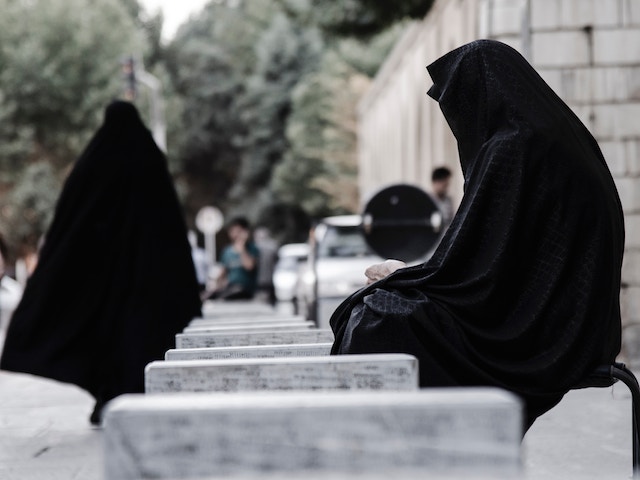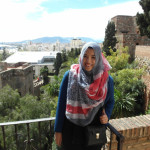How to Be a Woman in Saudi Arabia: Abayas, Hijabs, and Segregation

The Kingdom of Saudi Arabia (KSA), is not a tourist friendly place, in the sense that, you cannot go as a tourist. There was a brief period in 2013 where tourist visas were available, but no more. You can only gain entrance if you are performing hajj (the pilgrimage to Mecca for Muslims) or for business. So, when I got a chance to travel to Riyadh for work, I jumped at it.
I consider myself to be pretty open when it comes to culture. I don’t automatically feel that because something is different from my way of life that it is bad or incorrect. However, I was still nervous to go to KSA, mostly because I thought I’d be mad all the time. Mad, you say? Yes, mad.
You see, I am a strong, independent lady. I was once described as a “force of nature,” so the idea of going somewhere that has actual laws and policies restricting and prescribing what women are allowed to do was going to be hard for me to deal with. Women in KSA are still not allowed to drive. This is supposedly “for their safety” so that they don’t get mixed up in dangerous activities or tricked by salacious men. I know I said I am generally open-minded, but come on.
You see, I am a strong, independent lady. I was once described as a “force of nature,” so the idea of going somewhere that has actual laws and policies restricting and prescribing what women are allowed to do was going to be hard for me to deal with.
About an hour from landing in Riyadh, an announcement was made overhead on the plane. We were now entering Saudi airspace, and the crew would be coming through the cabin to collect any remaining alcoholic beverages. There was a mass exodus for the toilets so that women to put on their abayas.
The abaya is a garment that all women in KSA are required by law to wear. It is one of the most obvious symbols of sex-segregation. Men are required to wear respectful dress (no shorts, for example), but generally are able to choose what they want other than that. To me, an outsider, I felt like I was looking at a floating group of faces.
In addition, most of the women I met chose to wear some sort of covering on their head: whether it is a hijab, (often called the “scarf” or “headscarf” or niqab. I would like to note that in Islam this is meant to be a personal choice by the wearer, and I do not condone anyone being forced to wear a head covering.
While I was in KSA, I saw most women wearing the niqab, and a select few (about 1%) had an additional scarf over it, covering their eyes (but sheer, to see). I did not see one single burqa.
For someone like me who is used to describing people by saying things like “she’s blonde, has high cheekbones, kind of an hourglass figure,” this was really strange. It took away my ability to describe someone with the language I was used to. Instead, I said things like, “she’s an interpreter, has three brothers, her mom is a really good cook…” I really liked this, because I felt not only like women were being identified for their personality rather than looks, but also that people paid attention to me for the words coming out of my mouth and not my appearance.
This abaya is very plain, but they come in all sorts of designs. The one that I have has green sleeves, and another is adorned with gold embroidery and stones of different colours. I quickly learned that they are a fashion statement of their own.
To be honest, I wasn’t too worried about wearing the abaya. I tried to view it the way I would any other dress code: I wouldn’t wear a bikini to the Vatican, and I wouldn’t wear an evening gown to my office. I was really surprised though at how quickly I got used it and how other people reacted to me wearing it.
How to Be a Woman in Saudi Arabia: Abayas, Hijabs, and Segregation
I was in a shopping centre, which had all the normal US and European brands (Express, River Island, Zara…and lingerie shops as well), in the market for a new abaya. Saudi women are incredibly fashionable, and in women’s-only gatherings, the abaya is not required–only in the presence of non-family men. While shopping, a male shopping assistant was helping me (eventually, I went somewhere that was run by women, yay, lady power!).
I had taken off my abaya to try on another one, and he came around the corner. Well, you would have thought I had been walked in on totally naked. I jumped back in surprise, and covered myself with my abaya. This was the point at which I remembered I was wearing clothes–trousers and long sleeves. It’s all about what you’re used to.
While I was in KSA I wore the abaya, and I wore the hijab part of the time. I wore it at first because I felt like I had to and I was totally paranoid about it. It soon became apparent to me that what was even more respectful was being who I was while still following the legal requirements, even if it was a little bit different.
There were times when my hijab would slip off, and as I frantically rushed to fix it, Saudi people would say “Just leave it! It is no problem at all, don’t worry about it!” I even had a student ask why I was wearing the abaya, if I was not a Saudi or a Muslim. When I explained that foreign women had to take part in the rules, he made it clear that he thought it was a bit ridiculous. In the end, I mostly left my scarf around my neck, putting it on when going to and from the hotel (just out of respect, not necessity) and when I was talking to someone who I could tell was more conservative based on their own dress and behaviours.
How to Be a Woman in Saudi Arabia: Abayas, Hijabs, and Segregation
In addition to dress, all aspects of Saudi life are supposed to be segregated. What I really found though was that despite being segregated into men and women on the surface, KSA is really segregated into women and families and single men. Nevertheless, every morning I went through this entrance to work:

and stood in queues like this:

How to Be a Woman in Saudi Arabia: Abayas, Hijabs, and Segregation
In reality though, after I was through the door, I mixed right back in. Men and women stood next to each other at the stand to discuss universities, and despite being in technically separate queues I was directly next to men when ordering food.
I am pleased to say that despite all I had read on the internet, I did see a lot of women out by themselves, without their male guardians, or “mahrams”. I saw many women in groups, or even alone in the shopping centres–including women who had their hair uncovered. I rode in lifts/elevators with men without any problems, and I met genuinely friendly people. I was even given a free cupcake for being patient while a shop closed for prayer time.
Are people trusted so little that they can’t even be expected to “behave” themselves just by standing next to each other?
I’m sure it sounds like I am totally in love with the Saudi system of sex segregation. I want to make sure you all know, that I am not. Even as recently as February 2014, there are still tragedies, like the death of a young woman allegedly due to male paramedics being barred from entering the female campus.
Are people trusted so little that they can’t even be expected to “behave” themselves just by standing next to each other? Was the death of these women really worth preservation of the ideal that men and women don’t see each other in an “undressed” state? I don’t think so, and according to backlash on social media, Saudis don’t seem to think so either. I believe men and women are equals, and that the system is not only demeaning to women, but to men (in the idea that they are uncontrollable beasts) as well.
I was in KSA for a week, as a foreign woman at an international education conference. I loved it. Was I treated different than Saudi women because I was foreign? Probably. Could I live there day in and day out with the current restrictions? Not a chance. However, I went away with a much better understanding of the way things work and felt incredibly welcome and well-treated as a temporary visitor. I sincerely hope that others have the opportunity to experience this first hand, that the media will present both sides, and that I’ll be able to return someday!
How to Be a Woman in Saudi Arabia: Abayas, Hijabs, and Segregation top photo by Unsplash.









I always feel awkward around men, so I wouldn’t mind the segregation.
It was interesting to see how people interacted–I’m a pretty awkward person all the time! There’s a ramen restaurant in Brooklyn where you basically never have to interact with anyone-some days I would really like that!